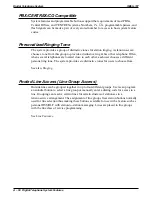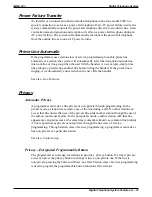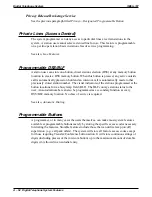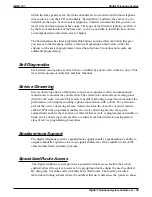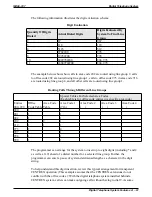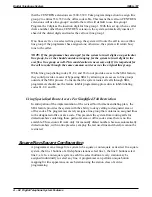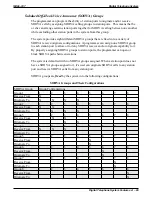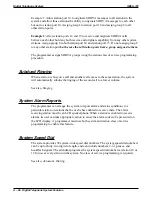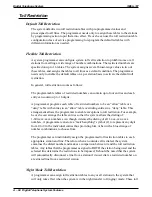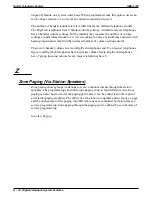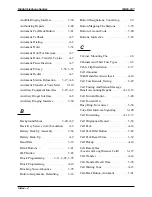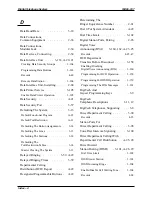
Flexible Station Numbering Plan
The system supports a flexible station numbering plan for individual stations. Each
station can be programmed to respond to the dialing of any available number between 10
and 7999. This feature may be used to match the calling number of a station located in a
pre-numbered area to that area number. A combination of two, three, or four digit
extension numbers can be assigned as long as they do not conflict. For example: If 21 is
assigned as an extension number, there can not be any other extension number assigned
that begins with a 21. The system class of service programming is used to assign
extension numbers to individual station ports.
Tenant Service
A system programmer can arrange for one telephone system to be used for multiple
tenants at a site location by employing flexible line appearance at each station. The
programmer can perform button mapping for line appearance on each station in the
system using the station class of service programming.
Station Monitoring With DSS Call Pickup
The busy lamp field (BLF) of a station can provide visual indication of the idle, busy,
and ringing status of monitored stations. This monitoring station can also provide audible
indication of any direct and delayed ringing that occurs at the monitored station if the
programmer has enabled the visual ring indication feature. A user at the monitoring
station can make a one-button pickup of a ringing call at a monitored station by pressing
the direct station selection (DSS) button associated with the ringing station.
The programmer can enable or disable the flashing BLF lights associated with visual ring
indication on a system-wide basis. When the programmer enables the flashing lights, he
or she can then enable the audible indication of ringing on a station-by-station basis.
Station Speed Dial
Each station provides 10 speed dial number locations at the keypad buttons. Station
speed dial numbers can be up to 16 digits in length and can include line or intercom
selection, numbers, #,
✳
, pauses, and hookflash signals. A user can store a pause by
pressing the HOLD button and store a hookflash signal by pressing the TAP button.
See also, Automatic Dialing.
IMI66–107
Digital Telephone System
Digital Telephone System Features A – 63
Summary of Contents for Air Impact DSU
Page 2: ...Printed in U S A GCA47 157 ...
Page 30: ......
Page 112: ......
Page 192: ...Digital Telephone System IMI66 107 3 80 System Programming ...
Page 283: ......
Page 284: ......
Page 285: ......
Page 286: ......
Page 287: ......
Page 288: ......
Page 289: ......
Page 290: ......
Page 291: ......
Page 292: ......
Page 293: ......
Page 294: ......
Page 295: ......
Page 296: ......
Page 297: ......
Page 298: ......
Page 299: ......
Page 300: ......
Page 301: ......
Page 302: ......
Page 303: ......
Page 304: ......
Page 305: ......
Page 306: ......
Page 307: ......
Page 308: ......
Page 309: ......
Page 310: ......
Page 311: ......
Page 312: ......
Page 313: ......
Page 314: ......
Page 315: ......
Page 316: ......
Page 317: ......
Page 318: ......
Page 319: ......
Page 320: ......
Page 321: ......
Page 322: ......
Page 323: ......
Page 324: ......
Page 325: ......
Page 326: ......
Page 327: ......
Page 328: ......
Page 329: ......
Page 330: ......
Page 331: ......
Page 332: ......
Page 333: ......
Page 334: ......
Page 335: ......
Page 336: ......
Page 337: ......
Page 338: ......
Page 339: ......
Page 340: ......
Page 431: ......
Page 436: ......
Page 437: ......
Page 438: ......


